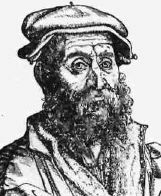

Niccolo Fontana was nearly killed as a teenager in 1512 when the
French captured his home town and torched it. Amidst the slaughter, the 12 year-old boy was dealt horrific facial sabre wounds that cut his jaw and palate and he was left for dead. He recovered, but in later life Niccolo always wore a beard to camouflage his disfiguring scars and he could only speak with difficulty, hence his nickname Tartaglia, or "stammerer".
Tartaglia was self taught in mathematics but, having an extraordinary ability, was able to earn his living teaching at Verona and Venice. As a lowly mathematics
teacher in Venice, Tartaglia gradually acquired a reputation as a promising mathematician by participating successfully in a large number of debates.
The first person known to have solved cubic equations algebraically was del Ferro but he told nobody of his achievement. On his deathbed, however, del Ferro
passed on the secret to his student Fior. Fior began to boast that he was able to solve cubics and a challenge between him and Tartaglia was arranged in 1535. Tartaglia discovered how to solve all cubics, whereas Fior had only been taught to solve some, so Tartaglia won easily.
Cardano was greatly intrigued when he learned of the contest and immediately set to work on trying to discover Tartaglia's method for himself, but was unsuccessful.
Cardano eventually tricked Tartaglia into revealing his method. He agreed to tell Cardano his method, if Cardano would swear never to reveal it and furthermore, to only ever write it down in code so that on his death, nobody would discover the secret from his papers.
Based on Tartaglia's formula, Cardano and his assistant Ferrari made remarkable progress finding proofs of all cases of the cubic and, even more impressively,
solving the quartic equation. Tartaglia made no move to publish his formula, despite the fact that, by now, it had become well known that such a method
existed. Tartaglia probably wished to keep his formula in reserve for any upcoming debates.
In 1545, Cardano published solutions to the cubic and quartic equations, and all of the additional work he had completed on Tartaglia's formula. Del Ferro and Tartaglia are fully credited with their discoveries, as is Ferrari, and the whole story written down in the text.
Tartaglia was furious when he discovered that Cardano had disregarded his oath.
To gain favor, Tartaglia agreed to debate Ferrari. Tartaglia was vastly experienced in such debates and expected to win. However, by the end of the first day, it was clear that things were not going Tartaglia's way. Ferrari clearly understood the cubic and quartic equations
more thoroughly and Tartaglia decided that he would leave Milan that night and thus leave the contest unresolved. With Tartaglia departing ignominiously, victory was left to Ferrari.
Tartaglia suffered as a result of the contest. After giving his lectures for a year in Brescia, he was informed that his stipend was not going to honoured. Even
after numerous lawsuits, Tartaglia could not get any payment and returned, seriously out of pocket, to his previous job in Venice.
Tartaglia did contribute to mathematics in a number of other ways. Fairly early in his career, before he became involved in the arguments about the cubic equation, he wrote
a paper on the application of mathematics to artillery fire. In the work he described new ballistic methods and instruments, including the first firing tables.
Tartaglia also wrote a popular arithmetic text, and was the first Italian translator and publisher of Euclid's Elements in 1543. He also published Latin editions of Archimedes's works.